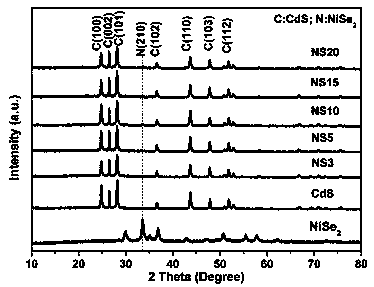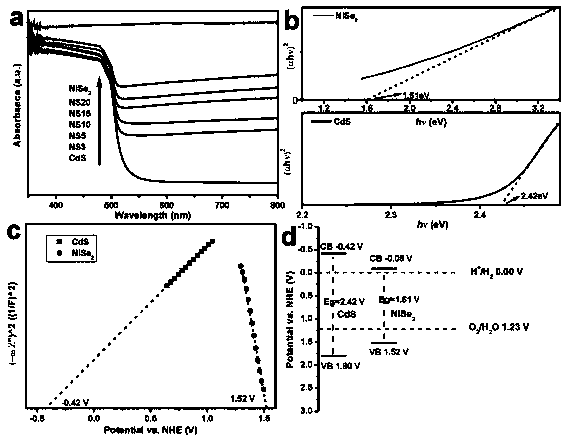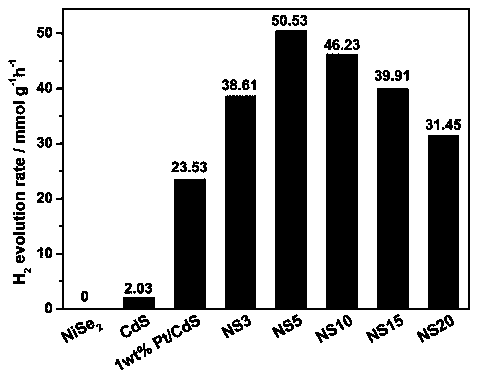Preparation method and aplication of supported photocatalyst NiSe2/CdS
A photocatalyst, supported technology, applied in catalyst activation/preparation, chemical instruments and methods, physical/chemical process catalysts, etc., can solve the problems of easy recombination and high cost of charge carriers, and achieve simple preparation process and conditions. mild effect
- Summary
- Abstract
- Description
- Claims
- Application Information
AI Technical Summary
Problems solved by technology
Method used
Image
Examples
preparation example Construction
[0017] The preparation steps of the present invention are as follows:
[0018] Preparation of CdS nanometers: Weigh 12.5 mmol of cadmium nitrate tetrahydrate and 37.5 mmol of thiourea into a 100 mL reactor lining, add 60 ml of ethylenediamine and stir to dissolve, then seal it in the autoclave , heated to 160 °C in an electric blast drying oven and kept for 24 h. After cooling down to room temperature, the precipitate was centrifuged, washed several times with water and ethanol, and dried in a vacuum oven at 80 °C for 8 h to obtain CdS nanorods.
[0019] Preparation of NaHSe solution: Weigh 2.857 g of sodium hydroxide and 0.228 g of selenium powder into a 50ml reaction kettle, add 25ml of deionized water and stir for 0.5 h, then seal it in a high-pressure reaction kettle, and place it in an electric blast drying oven Heat to 180 °C and keep it warm for 12 h, and wait for it to cool down to room temperature for later use.
[0020] Dissolve a certain amount of nickel nitrate h...
Embodiment 1
[0022] Dissolve a certain amount of nickel nitrate hexahydrate, trisodium citrate (27.69 μmolL trisodium citrate, the molar ratio of the former two is 1:1) and quantitative hexamethylenetetramine (0.25 mmol) in 40 mL of deionized water , then add 200 mg of CdS powder, ultrasonically disperse evenly, then transfer to the autoclave, keep at 120 °C for 12 h, and finally cool down to room temperature naturally; then add 0.719 ml of the prepared NaHSe solution into the above reaction autoclave The samples were kept at 140 °C for 12 h, and then naturally cooled to room temperature. The obtained samples were centrifuged with deionized water and absolute ethanol, and dried in a vacuum oven to obtain NiSe 2 NiSe with a loading of 3 wt% 2 / CdS(NS 3 ) heterojunction photocatalysts. Accurately weighed 5 mg of the synthesized powder catalyst was placed in a photo-splitting water reactor to test the hydrogen production performance of photo-splitting water.
Embodiment 2
[0024] Dissolve a certain amount of nickel nitrate hexahydrate, trisodium citrate (46.15 μmolL trisodium citrate, the molar ratio of the former two is 1:1) and quantitative hexamethylenetetramine (0.25 mmol) in 40 mL of deionized water , then add 200 mg of CdS powder, ultrasonically disperse evenly, transfer to the autoclave, keep at 120 °C for 12 h, and finally cool down to room temperature naturally; then add 1.199 ml of prepared NaHSe solution into the autoclave after the above reaction The samples were kept at 140 °C for 12 h, and then naturally cooled to room temperature. The obtained samples were centrifuged with deionized water and absolute ethanol, and dried in a vacuum oven to obtain NiSe 2 NiSe with a loading of 5 wt% 2 / CdS(NS 5 ) heterojunction photocatalysts. Accurately weighed 5 mg of the synthesized powder catalyst was placed in a photo-splitting water reactor to test the hydrogen production performance of photo-splitting water.
PUM
 Login to View More
Login to View More Abstract
Description
Claims
Application Information
 Login to View More
Login to View More - R&D
- Intellectual Property
- Life Sciences
- Materials
- Tech Scout
- Unparalleled Data Quality
- Higher Quality Content
- 60% Fewer Hallucinations
Browse by: Latest US Patents, China's latest patents, Technical Efficacy Thesaurus, Application Domain, Technology Topic, Popular Technical Reports.
© 2025 PatSnap. All rights reserved.Legal|Privacy policy|Modern Slavery Act Transparency Statement|Sitemap|About US| Contact US: help@patsnap.com



